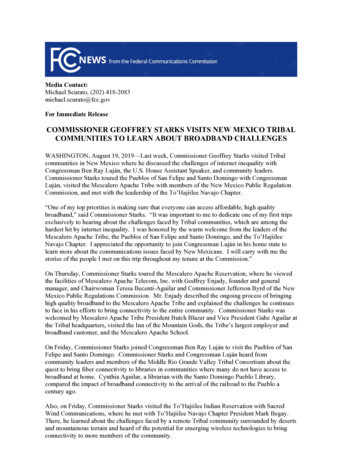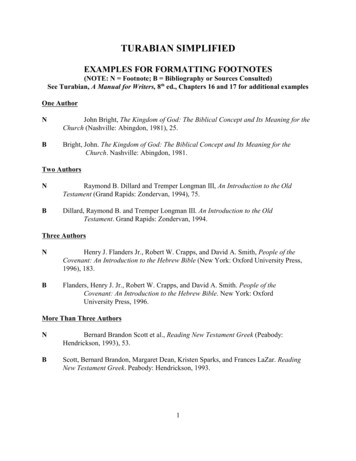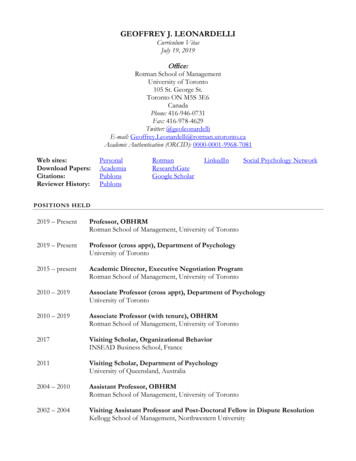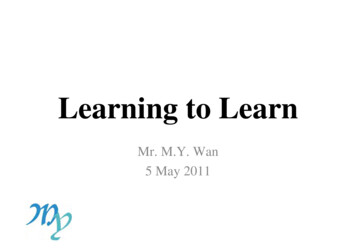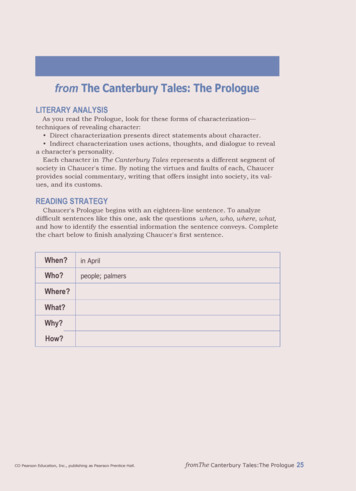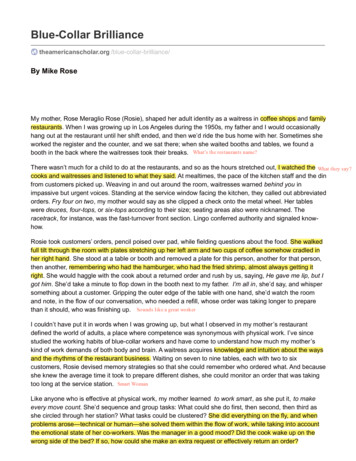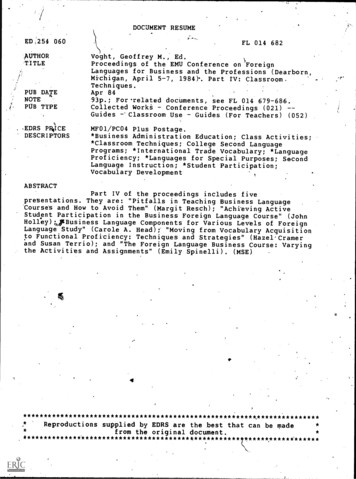
Transcription
DOCUMENT RESUMEED ;254 060AUTHORTITLEPUB DATENOTEPUB TYPE.-EDRS PRICEDESCRIPTORSFL 014 682Voght, Geoffrey M., Ed.NProceedings of the EMU Conference on ForeignLanguages for Business and the Professions (Dearborn,Michigan, April 5-7, 1984). Part rV: Classroom.Techniques.Apr 8493p.; Forrelated documents, see FL 014 679-686.Collected WorksConference Proceedings (021)Guides -"Classroom UseGuides (For Teachers) (052)MF01/PC04 Plus Postage.*Business Administration Education; Class Activities;*Classroom Techniques; College Second LanguagePrograms; *International Trade Vocabulary; *LanguageProficiency; *Languages for Special Purposes; SecondLanguage Instruction; *Student Participation;Vocabulary DevelopmentABSTRACTPart IV of the proceedings includes fivepresentations. They are: "Pitfalls in Teaching Business LanguageCourses and How to Avoid Them" (Margit Resch); "Achi*eving ActiveStudent Participation in the Business Foreign Language Course" (JohnHolley) OtBusiness Language Components for Various Levels of ForeignLanguage Study" (Carole A. Head);" "Moving from Vocabulary Acquisitionto Functional Proficiency: Techniques and Strategies" (Hazel'Cramerand Susan Terrio); and "The Foreign Language Business Course: Varyingthe Activities and Assignments" (Emily Spinelli). ************t****************Reproductions supplied by EDRS are the best that can be made**from the original ************ 1***********'******.*
4t,FOrITDINCF. OP TII,kFoRFTQN LANITAclPnR BULjNI,nN.I,VUPlinwFSIONS.11PP9T IV:CLAFf'HOOM.G/b-cfrorn.u 05hk,uS DEPARTMENT OF EDUCATIONNAIR)NAI INSTITUTF 01 IDUCATIONI ',INI:)1MAluggI 1),V A!,(0,At"PERMISSION TO REPRODUCE THISMATERIAL HAS BEEN GRANTED BYI.TO THE EDUCATIONAL RESOURCESINFORMATION CENTER (MCI'.4'.
l'ImFALLS IN TLACN1NC TTS/NI.SLtNCTWE COTTH6li.3AND 11')W TO AvoTD TIFF,Marrit RuchDepartment of Foreivn Lan ,uar,es and LiteraturesUniverity of F.outh CarolinaColumhialC. ;,)9P084vJIBEST COPY AVAILABLE
Pitfalls in Teaching Business Language Coursesand How to Avoid ThemA colleague was interrogated by her dean about the objectives'ofhercommercial Spanish course. She took a deep breath and began to outline hergoals: "I am trying to inform the students about business practices in Spainand Spanish speaking countries in Latin America. The texts!are selected to thisend and cover banking, management, industry and production, marketing,international finance and trade, labor relations, accounting, economicgeography,.transportation." Before she could finish her list oftopics, thedean expressed his bewilderment about the course content, wondering whetherhe was laboring under a false assumption when he thought that she was actuallya language teacher. "Oh, naturally, we are also developing the four languageskills: listening and reading comprehension, speaking and writing." The deanwas duely impressed, but with an air of sarcasm he inyired whether she hadany other ambitions. "Yes," she answered, "I do,.and I hope to realize themsomeday.I want Co throw an egg into an electric fan!"This little anecdote, comical as it may be, is actually quite revealing.Teaching a business language course is, indeed, a complex'4nd, at times, anoverwhelming task. Our'lack of training,in the discipline of internationalbusiness impairs our confidence asZeachers. The multitude of objectives, asindicated above, is not only impossible to accomplish, but often obstructs aclear view of what is essential and, thus, frustrates our attempts to setpriorities. It is not coincidental,I am sure, that the teacher listed asprimary course goals a series of business topics, while deveippment of languageskills was mentioned in passing. The emphasis in our coultse designs, as well asin current textbooks, seems to be on the realm of business as*we perceive it,rather than on pedagogically sound strategies for developing language skills.1
A typical syllabus and almost all textbooks reflect this preoccupation withinformation about business rather than linguistic content: both syllabus andtable of contents outline a host of business topics; but rarely addressthemselves to grammatical items or systematic practice of certain languageskills.We certainly need to'cover a broad spectrum of the prevalent businessconventions of a given foreign country. Yet, we need to ask ourselves what ismore important in a language elassmom: the content of the material or theacquisition of language skills. The teacher who argued that she had no time forconversation because there was so much business material Lc) cover in order toprepare the students for a certain standardized exam leading toward a businesslanguage diploma, has, in my opinion, lost sight of the most urgent objeCtivein business language classes: mastery of the language. Actual ly, the texts andmaterials should be selected, first and foremost, on the. basis of their usefulness towards this end. We are not trained and do not have the time to coveradequately all aspects of business. Therefore, it is imperative that we equipthe students With the linguistic tools that will enable them to obtain on their.own the information that we have to omit in the classrooncd that they mayevehtually, need. If we want students to achieve the necessary expertise toinform themselves about specific aspects of business and to communicatein anybusiness setting in the foreign language, we need to place emphasis on theimprovement of language skills.In the following, I will address myself to two of our tasks as languageteachers: development of reading and speaking skills. IfI ignore w iting, itOIris mainly for reasons of place constraints. However, I must admit, tongue incheek, that I consider writing of minor consequence for the internationalbusiness major as he or she will probably, having climbed the corporatp ladderF
to a managerial position, delegate any kind of written communication to his orher secretary.Particularly in'business language courses, we tend to practice reading andspeaking with distinctly different materials because a theoretical text onbusiness concepts does not seem to lend itself to oral communication. Who wouldever convers about, say,elementary contractual rights and liablities? Suchmaterial is, for good reasons, simply used for reading purposes, and.subjectmatters more conducive to oral practice are chosen for speaking. This approachis not necessarily practical and economical within the framework of an instructional unit as it imposes giant leaps from one topic to another and does notallow for thorough internalization and active masterrof any given subjectmatter. However, there are ways and means of utilizing a reading text of anykind for dynamic conversation, and I would like to acquaint you with somestrategies to practice both the.reading and speaking Skills on the basis of oneand the same text.Let us first consider some aspects of reading. The literature on thissubject is abundant, but although exciting and effective strategies forteaching and checking reading comprehension have been devised, actual classroominstruction is still willfully inadequate. The most prevalent method continuesto be translating a text into the native tongue, in spite of the generallyaccepted notion that translation has very little to do with reading, in fact,is often an obstacle to comprehension.) We haVe all experienced the generalfrustration when a student comes 9k with a .rendition such as: "Retail: He isthe last member in the trade chain and gives his wares in small crowds to theconsumer." And when the teacher inquires about the meaning of this nonsense,the student will respond: Well, this is what it says here. Of course, hetranslated literally a text that actually said: "Retail is the last link in the
marketing chain and sells small quantities of merchandise to Vie consumer."2Ifthe student had read the text for the purpose of comprehension rather thantranslation, he would surely have deciphered this sentence from the context andcircumscribed its meaning in cottprehensible words.Translation, by its very nature, requires precise knowledge of the meaningof every lexical item. Reading for comprehension does not. We do not need to befamiliar with every word in a text in order to be able to understand it. Let me.demonstrate to you that verbs:for instance, at least in written material, arenot necessarily "meaning-carrying" elements, as one reading specialist claimswho likes to teach reading through "recognition of distinctive features at thesyntactic level. "3 I want to prove to you that it is not necessary to know theexact meaning of a verb to grasp the meaning of the sentence, that, at least ina business text, verbs are, in fact, rather superfluous. In the following text,fill the blanks with an appropriate verb:Merrill Lyncha hefty'price - and perhapsa dangerous precedent - tothe Baldwin.L.i.United monkey off its back. The monkey in questionBaldwin's single-premium deferred annuity, a hot product that 4.toinvestor's money at top speed.Nobodymore annuities than Merrill Lynch brokers, who 30 million in commissions bysome40,000 of them, at a cost to the firm's customers of about 700million. After Baldwinthe courtstoholderstolast year,the assets of its insurance units. Unableat their savings without court approval, annuityMerrill Lynch Offic4 andlawyers all over the US, Fearful of long and costly litigation,,4ri
600Merrill Lynch's boardunanimously tothe annuities into Merrill Lynch obligations.4As you can see,. the correct context .can be established.without knowing theverb. That your choice of verb does'not always coincide with the-original doesin no may impair the accurate comprehension of the text.On the other hand, knowing the verb is helpful to deduce the meaning ofunfamiliar nouns. Fill with nouns the blank's of text (2) dealing with themr.social responsibility of the management of a company:Ifare to survive, they must make meaningfulto thein which they operate. In theUnited States,are generally free to satisfy theofby producingandof their own choosing. Yet, socialandstill serve to restrict and limit the5available to eachAgain, your choice of elements may not match the original, but most likelyyou established a meaningful context that approximates satisfactorily theoriginal. Exercises such as these simulate the situation of a studentattempting to decipher a text in a foreign language. Many lexical elements maybe unfamiliar to him, equivalent to blanks. However, more than likely, he knowsmany noun or verb phrases, thus, making. it easier for him to fill the remainingblanks, so to speak, than it was for you who, in this case, had no noun,respectively verb clues. Actually, these exercises can be used in class, in,English or in the foreign language, to prove to the students that comprehensiondoes not require the knowledge of every single word, no matter in whichlanguage the text is written.Of course, syntactical analysis of a sentence is a helpful tool for readingcomprehension if a text segment cannot be unraveled by way of its lexic and58
0/through inference. And which teacher is not gratified when the student hascorrectly located the subject! However, since I. M. Schlesinger demonstrated,early as 1968, that the method of decoding-a sentence does not substantiallysist the reading Comprehension process,6 his theory has been verified /inmany different studies,7 and we may well be wasting valuable time by insistingon careful syntactical analysis.Instead, we want to use our time for speaking; and filling the "blanks" with.proper words affords ample opportunity for discussion. Different possibilitiescan be weighed and assessed - in the foreign language. Arguments.can beformulated for or against a certain choice. And in the process of coming totermg-with the terminology, we are actively working with and, thus,reinforcingthe vocabulary of the text.' Moreover, at the same time, we are learning toexpress ourselves about the subject matter.There are many other ways of accomplishing this goal. The usual questionsabout-the-text method is not one of them; regardless of whether those questions are in the foreign language or in English. Consider text (3) and thequestions typically devised for reading checks and conversation exercises:International bankers are in a froth over Citibank's refusalto repay about 550 million of maturing US dollar deposits in its7Manila branch. Attracted in part by high interest rates,thebiggest depositors include Japanese and Canadian banks. Citibanksays that paying them off would violate foreign exchange controlsslapped on by the Philippines last fal1.8a) Who is in a froth?b) What is attracting Japanese and Canadian banks?c) What would be the consequence of paying the depositors off?d) When did the Philippines slap on foreign exchange controls?6
Even if you did not know the language, you would probably be able to pickout the subject after which.the first qu6stion inquires. And most of the otherquestions can easily be answered without really comprehending the text. Therefore, this method is not adequate to generate or check comprehension. Neitherdoes it'inspire conversation. As soon as those questions are answered,probably by'mindlessly reiterating the text verbatim, communication isterminated.It us consider some alternatives to practicing reading and speakingsimultaneously. -Talic/the following text:"Decision making is important in all managment activities.Infact, the management functions could not be performed if.As a process, decisionmaking refers to the selection of one action from a number ofalternatives available for solving a problem. In this sense,1are 0(3 examples of decision making.The decision making process is composed of four basic steps:1)2)3)analyzing alternatives in terms of their preceived consequences94)In groups, the students are to read the text and help each other decipherits meaning. No English is allowed. There are several ways to fill the blanks.The actual text pieces can be listed, in scrambled fashion, on the bottom ofthe page and the students have to locate the proper one for each blank:7o
- a) 40, determining retail pricesb) determining alternativesc) if.decisions were not made,d) hiring new employese) selecting a course'of action) adding a new product to existing linesg) defining the problem.;Each choice requires a verbal justification, for instance: "Hiring a/hewemployee is an example of decision making. The manager must decide-whichone ofthe applicants to employ." Or: "In order to be able to make a decision,youfirst have to define the problem. Defining the problem is the /first step."An alternative, which does not provide the missing parts 4nd is, therefore,more apt to elicit lively conversation, is a group discussipn in,which thestudents are to speculate on the ideas omitted and genera/te statements thatwould adequately complete the sentence and round offthAcontext. This/presupposes some knowledge about the subject matter or simply common sense,depending On the nature of the text. The group membets will propose and,subsequently defend, their ideas for filling the blanks and discusswhichsuggestions best fit the context. After extensive group .work, the differentproposals can be assessed by the entire class, giving opportunity for reviewAtand reinforcement of the material. The suggestions that approximate theoriginal should receive special laudations.For both exercises, the reading passage has to be thoroughly understood orelse the task of fillingthe blanks to produce sensical-statements cannot beaccomplished. In my experience, the students find this aprroach to readingchallenging and they really labor to comprehend the text, which is not alwaysthe case with more conventional methods where the students are inclined to,sgaply ignore what- they do not' understand, and where they can get away with it.With this technique, it is imperative that they understand the text. Moreover,to arrive at a consensus in the face of various possibilites, the group members8
60ywill have to engage in a meaningful verbal exchange which often times proceedsto heated but fruitful arguments, even over short and modest texts such as theone above. Such. discussionsre infinitely more interesting and productive in/-terms of developing oral facilities than answering'dead-end questions about thetext. Furthomore, Since.this approach requires active contemplation of thesubject matter and creative solutions to each given problem, studenttend tolearn the concepts better and commit/th6 material to long-term memory.An ther Interesting method to inspire thorough reading and subsequent:convertion is the Humpty-Dumpty method. Divide a text into severascramble them up. The students' task is to repcomponentsuce the original byrearranging the giv'en parts. Put the following text segMents in a logical-sequence or,in nursery rhyme words, put them back top ether again:1) Such concerns have sent the Dow Jones Industrial average plummeting110' points in the past month.2) Said Walter Heller, who was chief economic adviser to PresidentsKennedy and Johnson:3) First the recovery took off far more powerfully than nearly allexperts had expected.,4) At a meeting last week in Manhattan, the members of. TIME's Board ofEconomists foresaw continued grow' h this year,5) From the start, the rebound from' the, grinding 1981-82 recession hasbeen filled with sharp suprises.6) "The expansion 'won'(peter out, but will peter down."7) Now the prospect of further giant federal deficits is raising fearsthat the upturn may abruptly end.8) but predicted that the recovery's pace would slow.10Almost total comprehension is a prerequisiteo reproduce the original. Eachtime a sequential order is established, the studients have to provide a justi-fication. In the process of rearranging the seents, ample opportunity isgiven for extensive disCussions about the matOial, both conceptual and!syntactical - if sentences were broken up.
Such methods demand close reading and careful selection of texts on the partof the teacher, because not all texts lend themselves to such exercises. TheHumpty-Dumpty.method only works with a text that is logically'structured; whichis,'unfrtunately, not always the case with business texts, espeCtally articlesin newspapers and magazines. Filling -in blanks requires well written materialsthat address themselves to the potnt, develop it elOarly and do not take off on.a tangent, so that speculation about the omitted materials can focus on theproblem at hand.41111While devising such exercises takes time, the results are well worth theeffort. But there are other strategies' that do not require elaborate,prepa-rations, yet, fOrcethe'students to try to understand the text. 11 Forinstance, a text can be handed out that is not divided into paragraphs: TheStask, then, is to analyze the logic of the twit and structure it visually in1.frsuch A way.as to reflect its internal organization. These'paragraphs could begiven appropriate headings that'ate either prgdded by you, scrambled-upqfashion, or have to be'devised by:the students themselves.Texts, that contain a wealth of statistics, dealing, for instance,witheconomic growth, yl h easily be illustrated with corresponding graphs - most,,A'classes lo\m,such activities. Though by their very nature npn-verbal, suchadtivittes are by no means frivolous, because in ordet to produce such charts,---/ *thorough understanding of the text is necessary.And all-the while, t*.5,tudents, working in groups, have to explain the:reasons for,their way of manipulating' the text and communiOate about everystepof their current activity.- Thus, they are forced to use the vocabulary,'Iactively and they tend to absorb the material, even if they are only modestlymotivated and prone to learning by way of osmosis rather than diligent andoactive acquisition,'I.lo
606Such strategies may have found and will continue to find their way into theclassroom. First and foremost, howeve, they should be employed by the authorscif textbooks (that'we so direly need); authors who seem to steadfastly cling tothe notion that reading and speaking,(and'for that matter, writing) areseparate activities to be conducted separately with distinctly differentmaterials. Let, us hope that -these authors will begin to create or emutate-'didactically more'innovat ive teaching stratagems and discontinuedscontinue the stiflingpractice of providing a text with the usual series of demeaning and hom questions.LFOOTNOTES1Ralph W. Ewton, "Reading vs., Translation," German Quarterly, 42, Jan.1969, pp. 126-127.Harald Walter Braun; "Functional Skills for German in Business and Economy: ACurricular, Guide and Materials for the Teaching of Business German," Diss.Stonybrook 1980, P. 227: "Der Einzelhandel: Er ist das letzte Glied in derHandelskette and gibt die Waren in kleinen Mengen.an die-Verbraucher ab."Bruce A. Beatie, "Developing Reading Skills in German: An UnorthodoxApproach," ed. Helm Faber and Manfred Heid, Lesen in der Fremdsprache(Munich, 1981), p. 22f.4 "Birk's Bailout," Fortune, 20 February 1984,.p. 6:.1Werri1l Lynch is paying a hefty price - and perhaps setting a dangerousprecedent - to get the Baldwin-United monkey off its back. The monkey inquestion is Baldwin's single-premium %ieferred annuity, a hot product thatpromised to compound investors' money at top speed. Nobody peddled moreannuities than Merrill Lynch brokers, who collected 30 million in commissions by selling some 40,000 of them, at a cost to the firm's customers ofabout 700 million. After Baldwin began to topple last year, the courts frozethe assets of its insurance units. Unable to get 4,t their savings withoutcourt approval, annuity holders have picketed Merrill Lynch offices andlined up lawyers all over the US. Fearful of long and costly litigations,Merrill Lynchl,s board voted unanimously to convert the annuities intoMerrill Lynch obligations."5 Trewart and Newport, Mgnagement.: Functiobs.and Behavior (Dal las, 1977),P 8:1 el(
4,"If organizations are to survive, they must make meaningfulcontributionsto the society. in whibh they operate. In the United States,busineAs enterprises are' enerally free to satisfy the needs ofsociety.by,producing goodsand services of their own choosing. Yet, the social valuesand.normsstill.serve to restrict and limit the alternatives available to.eachorganization."6 I.M. Schlesinger, Sentence Structure and the Reading Process(The Hague,1968).7 Kenneth Goodman; "Decoding - from Code to What?," Journal of Reading, 14(1971), 455-462.David LaBerge, Basic Processes in Reading: Perception and(Comprehension (NewYork, 1977).8 "Chiller in Manila," Fortune,20 February 1984, p. 7.9 Trewart and Newport, op. cit., 50:"Decision making is important in all management activities.In fact, themanagement functions could not be performed if decisions were not made. As aprocess, decision making refers to the selection of one action from a numberof alternatives available for solving a problem. In thiSsense, hiring newemployees, adding a new product to existing lines, anddetermining retailprices are examples of decision making.The decision. making process is composed of four basicsteps: (1) definingthe problem; (2) determining the alternatives; (3) analyzingalternatives interms of their perceived consequences; and (4).selecting acourse ofaction."10 "Still Sighting Favorable Signs," Time, 27 February 1984, p. 72.Correct sequence: 5-3-7-1-4-8-2-6.11Rosemarie Buhlmann, "Das Lesen von Fachtexten," Lesen in der Fremdsprache,ibid., 55-124, offers a wealth of suggestions regarding reading checkmechanisms for scientific texts.Margit ReschUniversity of South Carolina12602
66)8ACHI VVTNC ACTIVE STuDENT PARTICIPATION TN TIE WSINESSFORnCTI LANGUAGE COURSEohnDepartment n f- TolleyForeignLanfruafresminion UniversityTorfnlk, VA MO8BEST COPY AVAILABLE
6,09Student Participation 1Foreign language teachers who find themselves faced withthe responsibility for developing a so- called "business" coursein a foreign language share a spt of'wellTknown task-relatedproblems,Whether such teacher's come to this responsibility'of their own accord or have it thrust upon them by senior,.members of the department who give their blessings but littleelse to the projeet has no bearing ,on the scope or magnitudeof the 'problems that lie.ahead. .0For in almost every casethe teachers who undertake to design and offer a business.,foreign language course are themselves trained humanists, i.e.ones who are at home in the subtleties of textual criticismin the literary jObrnals'they read and possibly contribute to,'but who also feel somewhat uncomfortable with terms like"Dow Jones" and Ilexport subventOm."But it is a very, smallsource of comfort in4e'ed to suspect that we are all subjectto the same feelings of uneasiness.Misery may Jove company,but it is a short7lived diversion at best when the companyMerely serves to remind us of the,prohlem.This paper will'examine some of'the cads(s of our shared uneasiness and offerworkable, practical suggestions for dealing' with them.My topic isthe achieviiig,of active student participationin the business-foreign language'course, and so one might,well ask at thil point'Wfly this paper is starting off,by.addressing teacher insecurity.getting,students involved?What does that have to do withIn fact, it has everythin'g to do4.
6/pStudent Participation 2with getCing students involved.The atmosphere in theclassroom will either make our goal of student involvementpossible, or it will preclude it.And a mostingredient of the classroom atmosphere is the self-confidenceof th'e teacher.Anyone who has ever entered the classroomwith forebodings of doom knows front first-hand experiencethe meaning of "a self-fulfilling prophecy."Let us thenconsider the three major contributors to insecurity for theteacher of the busipess foreign language course and then lookat a simple, realistic design for a course that will replaceinsecurity with confidence and fear with fun.What, then, are the fears that can erode confidence andpreclude the creation and control of a classroom atmospherethat promotes the learning process?If we recall the firstimpressions we had when perusing the materials available forthe business foreign language course, we may also'lememberthat "sinking feeling" that went along with those impressions.Not only was the vocabulary new, the concepts were, and tosome extent will probably remain, nothing short of alien.None of those nice philosophical terms appropriate to adiscussion of Don Quixote or Faust will do here.For alltheir beauty, they are simply out of place and must be leftbehind.Our next impression could be compared to the aweAbraham felt when contemplating the night sky.The depth andbreadth of thejield encompassed by the innocuous little18
Student Participation 3word "business" in its adjoverwhelming.tival or .substantive uses is justThe final impression and third contributor toteacher insecurity grows out of the first two.If we feelalienated by the subject matter and overwhelmed by its vastness,we will certainly begin to dread the moment we must standbefore a group of students who believe they have every rightto expect us to know it all.Row can we be creative andstimulating in the classroom under these circumstances?Willthis course give new dimension to the terms "dry" and"pedantic"?After all, just how exciting is, for example,thebusiness section of the newspaper to the'citizen?averageEven Dan Rather has more sense that to jeopardiie the popularity,of the evening news by giving more than a nod to the dailystock market report.Newness, vastness and dryness, thetriple threat guaranteed to give sweaty palms to even themost experienced of teachers.How can we neophites in thearea of foreign languages for business and the professionsavoid getting in over our heads, floundering, and failing inour efforts to provide a college-level educational experience?The answer is not necessarily simple,but the answer that willbe suggested here is workable and fun, and, what it more,anyone can use it successfully.The key to success in this course is, not surprisingly,the same as for any other course.The objectives of thecourse must be realistic, realizable, and clear.19Although
Student Participation 4this course is not conceived of as being a beginningTlevelforeign language course (in fact, the students should havehad two to three years of the foreign language at the collegelevel), it is a beginning business foreign language course,and the assumption should be that the students are as new to.the field as they would be to the study of Golden Age Spanishliterature.No one familiar with the field of Spanishliterature would expect an undergraduate-course in the GoldenAge to do any more than provide the students with anintroduction, a "leg up," as it were, into the field.Theobjectives would be to make the students aware of the periodthrough, firsthand involvement with some of its representativeworks.The hope would be that the students would gainrespect for an important cultural achievement and becomefamiliar with some of its significant ideas and their expressionin literature.The objectives would be realistic, given thetime alloted and the previous preparation of the students.OThey would be considered realizable, perhaps even modest, butno less worthwhile for that, given the richness and scope ofthe field in question.,These practical objectives should be'clear in the mind of the teacher, and they should be madeclear to the students as well.The professional humanist knows well enough how to goabout planning the objectives of a genre or'period course-inliterature, and we may, indeed ought to apply the same20
6/.3Student Participation 5criteria in our planning of.a business foreign language cours
Merrill Lynch a hefty'price - and perhaps. a dangerous precedent - to. the Baldwin.L. i. United monkey off its back. The monkey in question. Baldwin's single-premium deferred annuity, a hot product that 4. to investor's money at top speed. Nobody more annuities than Merrill Lynch brokers, who. 30 million in commissions by some
